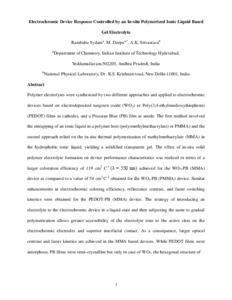Sydam, R and M, Deepa and Srivastava, A K
(2012)
Electrochromic device response controlled by an in situ polymerized ionic liquid based gel electrolyte.
RSC Advances, 2.
pp. 9011-9021.
ISSN 2046-2069
![[img]](http://raiithold.iith.ac.in/161/1.hassmallThumbnailVersion/RSC_advances_2012.pdf)  Preview |
|
Text (Author version post-print)
RSC_advances_2012.pdf
- Accepted Version
Download (2MB)
| Preview
|
Abstract
Polymer electrolytes were synthesized by two different approaches and applied to electrochromic
devices based on electrodeposited tungsten oxide (WO3) or poly(3,4-ethylenedioxythiophene)
(PEDOT) films as the cathode, and a Prussian blue (PB) film as the anode. The first method involved
the entrapping of an ionic liquid in a polymer host (poly(methylmethacrylate) or PMMA) and the
second approach relied on the in situ thermal polymerization of methylmethacrylate (MMA) in the
hydrophobic ionic liquid, yielding a solidified transparent gel. The effect of in situ solid polymer
electrolyte formation on device performance characteristics was realized in terms of a larger
coloration efficiency of 119 cm2 C21 (l = 550 nm) achieved for the WO3–PB (MMA) device, as
compared to a value of 54 cm2 C21 obtained for the WO3–PB (PMMA) device. Similar enhancements
in electrochromic coloring efficiency, reflectance contrast, and faster switching kinetics were obtained
for the PEDOT–PB (MMA) device. The strategy of introducing an electrolyte to the electrochromic
device in a liquid state and then subjecting the same to gradual polymerization allows greater
accessibility of the electrolyte ions to the active sites on the electrochromic electrodes and superior
interfacial contact. As a consequence, larger optical contrast and faster kinetics are achieved in the
MMA based devices. While PEDOT films were amorphous, PB films were semi-crystalline but only in
the case of WO3; the hexagonal structure of WO3, equipped with three/four/six-coordinated voids was
found to affect bleaching kinetics favorably. The performance of PMMA based electrolyte is limited
by high resistance at the electrode–electrolyte interface, and a smaller number of ions available for
oxidation and reduction. Large area (y10 cm 6 4 cm) devices were also fabricated using this simple
wet chemistry method and their ability to color uniformly without any pinholes was demonstrated.
Actions (login required)
 |
View Item |


 Altmetric
Altmetric Altmetric
Altmetric